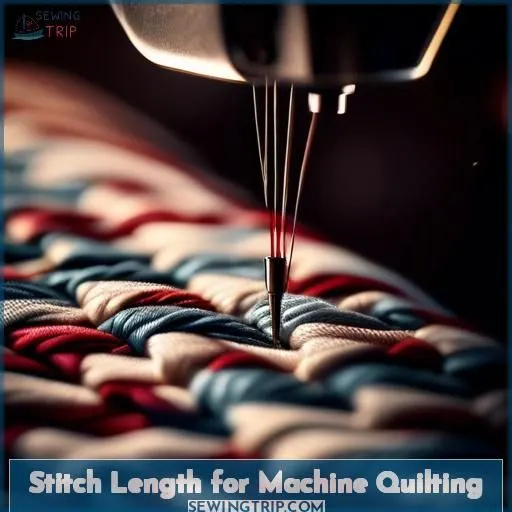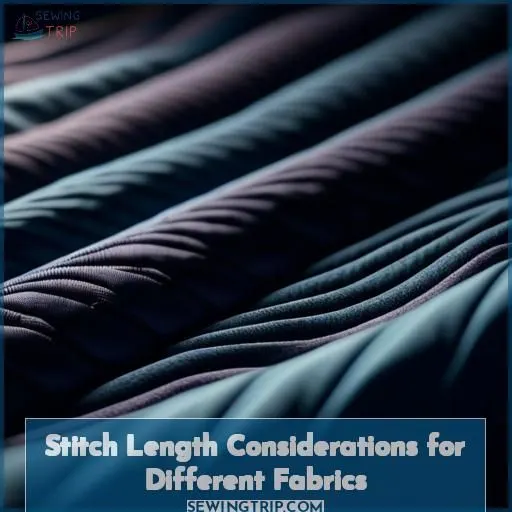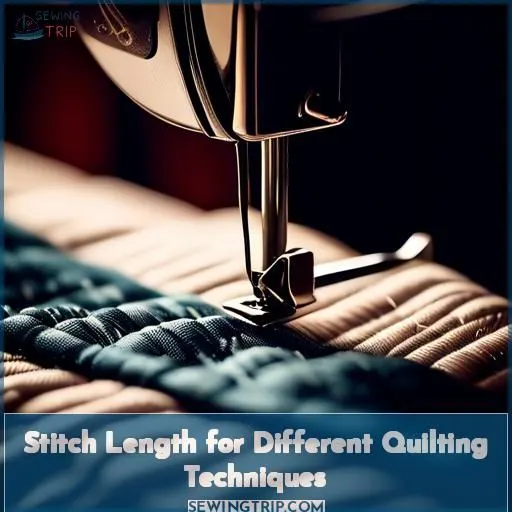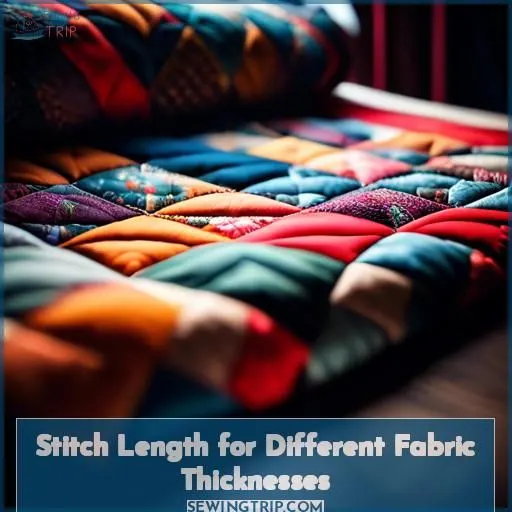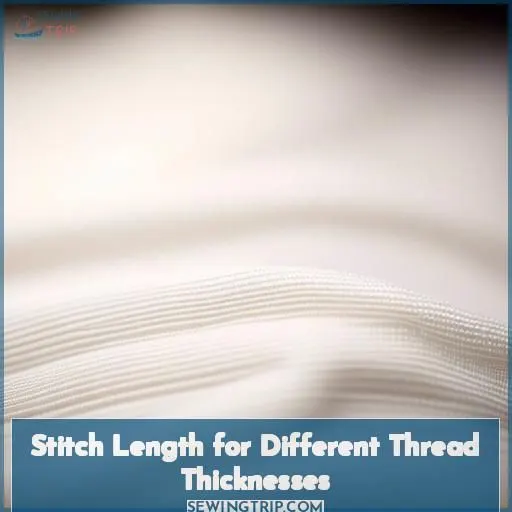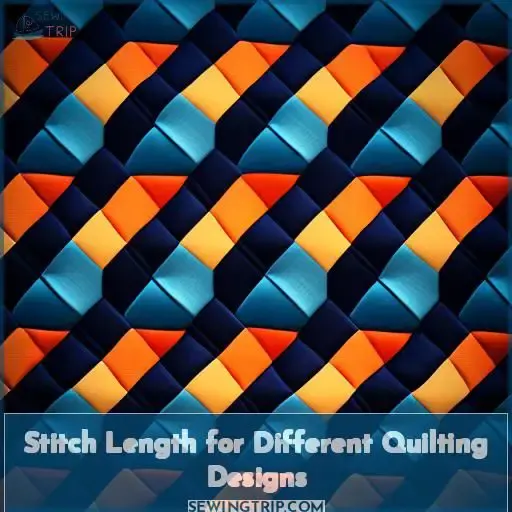This site is supported by our readers. We may earn a commission, at no cost to you, if you purchase through links.
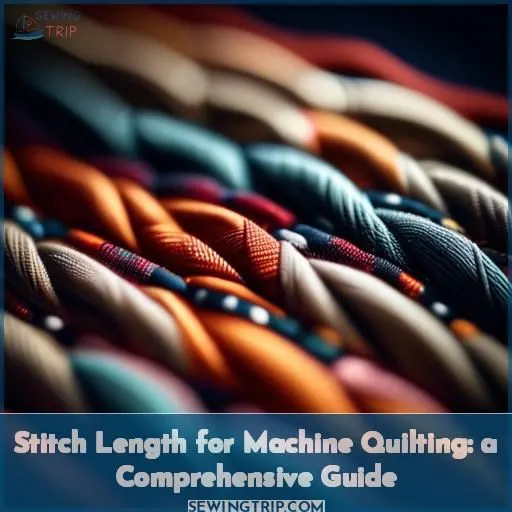
To obtain optimal outcomes in machine quilting, utilize a stitch length of 5 to 8, which corresponds to 8 to 12 stitches per inch. This stitch length is appropriate for novices and standard quilting thread, delivering a well-rounded and consistent stitch design.
Remember to account for the fabric type and thickness, as well as the thread thickness, when selecting your stitch length. Test your stitch length on a spare piece of fabric prior to quilting your project to guarantee the best possible results.
Table Of Contents
- Key Takeaways
- What Stitch Length Should I Use for Machine Quilting?
- Stitch Length for Machine Quilting
- Stitch Length Considerations for Different Fabrics
- Stitch Length for Different Quilting Techniques
- Stitch Length for Different Fabric Thicknesses
- Stitch Length for Different Thread Thicknesses
- Stitch Length for Different Quilting Designs
- Frequently Asked Questions (FAQs)
- Conclusion
Key Takeaways
- The recommended stitch length for machine quilting is 5-8, which translates to 8-12 stitches per inch.
- This stitch length is suitable for novices and standard quilting thread, delivering a well-rounded and consistent stitch design.
- The choice of stitch length can be influenced by factors such as fabric type, thread thickness, and quilting method.
- It’s important to test your stitch length on a spare piece of fabric before quilting your project to ensure the best possible results.
What Stitch Length Should I Use for Machine Quilting?
For machine quilting, the ideal stitch length is typically between 2.5 and 3.5 millimeters, which balances aesthetics and durability. This range ensures stitches are small enough to hold the quilt together securely while also being large enough to be efficient and visually pleasing.
Stitch Length for Machine Quilting
In the realm of machine quilting, the advised stitch length generally ranges from 2.5 to 3.5, which translates to 8 to 12 stitches per inch. This spectrum is appropriate for budding quilters and commonplace quilting thread, ensuring a harmonious and unwavering stitch pattern.
The selection of stitch length can be influenced by considerations such as the nature of the fabric, the sought-after visual appeal, and the particular quilting method employed.
Recommended Stitch Length: 2.5 – 3.5 (8 – 12 Stitches Per Inch)
For machine quilting, a recommended stitch length range is 2.5 to 3.5, which translates to 8 to 12 stitches per inch. This stitch density can be influenced by factors like fabric type, thread weight, and design elements.
By adjusting your machine’s stitch length, you can achieve a balance between aesthetics and stability for your quilt.
The stitch length for machine quilting is essential for the overall look and strength of your project.
Suitable for Beginners and Regular Quilting Thread
Adjusting stitch length on a sewing machine is a vital element of quilting, as it affects the strength and aesthetics of your stitches. Here’s a breakdown of stitch length for machine quilting:
Recommended Stitch Length: 5 – 5 (8 – 12 stitches per inch)
Stitch Strength and Appearance: Longer stitches provide a cleaner look but are less stable, while shorter stitches are more stable but can appear uneven. The stitch length influences the amount of stress each stitch can withstand.
Adjusting Stitch Length: Stitch length is controlled by the feed dogs of the sewing machine. The lower the number, the less the feed dogs advance the fabric, resulting in a shorter stitch length. Conversely, the higher the number, the more the feed dogs advance the fabric, resulting in a longer stitch length.
Factors Affecting Stitch Length Choice: The choice of stitch length depends on factors such as whether the stitches will be visible in the finished quilt, their purpose in the quilt, and whether a larger or smaller stitch might be more suitable.
Recommended Stitch Lengths for Different Techniques: Machine quilting: 2.5 – 3.5 for aesthetics; piecing quilt blocks: 2.5 for strength; foundation paper piecing: 2 for easy paper removal; seam basting: 4 for temporary hold; free motion quilting: 2.5 – 3.5 (manual) for aesthetics; hand quilting: 3.5-4 (manual) for convenience.
Considerations for Different Fabrics: Use shorter stitch lengths for delicate fabrics, longer stitch lengths for stretchy fabrics, shorter stitch lengths for durability, and longer stitch lengths for artistic effects.
Test Stitch Length: Test stitch length on a spare piece of fabric to guarantee the best results for your project.
Foundational vs. Decorative Stitches: Foundational stitches secure fabric together, while decorative stitches add embellishment or style. Both types of stitches can be used for practical or aesthetic purposes.
Math Behind Stitch Length: 25.4 millimeters in one inch. The formula: 25.4 / stitch length = stitches per inch. The inverse formula: 25.4 / stitches per inch = stitch length.
Average Machine Quilting Stitch Length: The average machine quilting stitch length chosen is between 10 and 11 stitches per inch.
Thickness of Thread: Fine thread (100wt silk) requires smaller stitches to avoid a basting-like appearance, while thick thread (pearl cotton) requires longer stitches to prevent a stiff look.
Quilting Design: Smaller design elements require shorter stitches for smooth curves, while larger design elements allow for longer stitches while maintaining a clean line.
Free Motion Quilting: Stitch length is controlled by the quilter. Smaller stitches are used for intricate designs, while longer stitches are used for larger designs.
Even Stitches: Hallmark of good quilting. Stitch length should be consistent throughout the design, determined by the smallest element in the design.
Provides a Balanced and Consistent Stitch Pattern
In the realm of machine quilting, achieving a harmonious and uniform pattern is paramount. This entails selecting a stitch length that strikes a balance between aesthetic appeal and durability, contingent upon the intended use of your quilt. For novice quilters and standard quilting thread, a suggested stitch length is 5-5 (8-12 stitches per inch). This range offers a harmonious equilibrium between foundational stitches that secure your quilt and embellishing stitches that lend a touch of elegance.
Bear in mind that the stitch length you opt for can profoundly influence the visual and tactile qualities of your quilting designs, so experiment with various lengths on a sample fabric to ascertain the most suitable setting for your project.
Stitch Length Considerations for Different Fabrics
When selecting a stitch length for machine quilting, take into account the fabric you’re working with. Delicate fabrics necessitate shorter stitches to avert damage, while stretchy fabrics gain from longer stitches to preserve their shape.
For durability, shorter stitches are favored. For artistic effects, longer stitches can be employed.
Always test your stitch length on a spare piece of fabric to guarantee the best results.
Use Shorter Stitch Lengths for Delicate Fabrics
Moving from general quilt making, when working with delicate materials, it’s akin to navigating a fragile path—requiring precision. The crux of it is:
- Stitch Stability: Opt for smaller stitches; they’re like a tightrope walker’s pole, maintaining balance.
- Fabric Strength: Short stitches act like a supportive ally, keeping things secure without overpowering.
- Aesthetic Effects: Strive for stitch uniformity; it’s the key ingredient for a visually captivating creation.
Use Longer Stitch Lengths for Stretchy Fabrics
When working with stretchy fabrics in machine quilting, it’s vital to modify the stitch length to achieve the best outcomes. Stretchy fabrics like lycra, two-way stretch knits, and silk jersey demand longer stitches to accommodate their inherent flexibility. The recommended stitch length for these fabrics is usually around 3.0 to 4.0mm. This extended stitch length permits the fabric to move freely without inducing tension or puckering.
To attain the desired stitch length, you can employ a larger needle, such as a 90/14 topstitch needle, and modify the needle tension to suit the fabric’s stretch. Moreover, using a walking foot or a free-motion foot may be necessary to guarantee that the stitches are distributed uniformly across the fabric.
When selecting the stitch length for stretchy fabrics, consider the fabric’s thickness and the thread tension. Thinner threads like silk or rayon may necessitate a shorter stitch length to avoid a basting-like appearance, while thicker threads like pearl cotton may require a longer stitch length to prevent a rigid look.
Remember to test the stitch length on a scrap piece of fabric before quilting to ensure that the stitches are even and the fabric isn’t being stretched or puckered. This will aid in determining the ideal stitch length for your specific project and fabric.
Use Shorter Stitch Lengths for Durability
Regarding quilting, stitch length is fundamental in deciding the sturdiness and lifespan of your creation. Shorter stitch lengths can offer greater strength and durability, rendering them suitable for diverse quilting techniques and fabric types. Here are some pivotal points to ponder when picking stitch lengths for durability:
- Uniform stitch length: Guarantee that the stitch length remains consistent throughout the quilt to uphold equal seam strength.
- Thread type: Select threads that are strong and pair well with your fabric type. For instance, all-cotton threads are often favored for piecing quilts, as they strike a balance between strength and ease of use.
- Fabric thickness: Adjust stitch length based on the thickness of the fabric. Fabrics of greater thickness may require longer stitches to avert damage to the thread, while fabrics of lesser thickness may profit from shorter stitches for enhanced seam strength.
- Machine quilting: For machine quilting, a recommended stitch length is 2.5-3.5 millimeters, which strikes a balance between aesthetics and durability.
- Walking foot quilting: Employing a walking foot can assist in maintaining consistent stitch length and seam width, which is imperative for durability.
Use Longer Stitch Lengths for Artistic Effects
After nailing durability with shorter stitches, it’s time to switch gears for the wow factor. Crank up your stitch length for walking foot quilting, and let those longer threads dance across the fabric, creating a visual impact that sings.
Think of decorative stitching as the spice of your textile art—just a dash transforms the mundane into a masterpiece of aesthetic appeal.
Test Stitch Length on a Scrap Piece of Fabric
Before you embark on your pivotal undertaking, it’s prudent to conduct a trial run on a spare fabric specimen. This brief experiment will safeguard the impeccable execution of your masterpiece.
- Verifying precision hones your needlework acumen.
- Stitching uniformity is the cornerstone of quilting excellence.
- Explore various needle calibers; they’re your artistic instruments.
- Modify spool tension to avert any stitching mishaps.
Stitch Length for Different Quilting Techniques
To craft a visually appealing and long-lasting quilt, it’s imperative to grasp the significance of stitch length in diverse quilting methods. For machine quilting, a stitch length of 5-8 (8-12 stitches per inch) is advisable, offering a harmonious and uniform stitch pattern appropriate for novice quilters and standard quilting thread.
The selection of stitch length can fluctuate based on the technique and fabric type. Foundation paper piecing mandates a shorter stitch length of 2 for effortless paper removal. Conversely, seam basting necessitates a longer stitch length of 4 for a transient hold.
In free motion quilting, the stitch length is manually controlled, with shorter stitches for intricate designs and longer stitches for larger designs. Hand quilting likewise provides flexibility, with a suggested stitch length of 5-4 (manual) contingent on the desired effect and fabric type.
Machine Quilting: 2.5 – 3.5 (aesthetics)
Concerning machine quilting, the stitch length selected can notably affect the aesthetic quality of your undertaking. The optimal range for most quilters resides between 2.5 and 3.5 millimeters, which corresponds to 8 to 12 stitches per inch. This range suits novices and standard quilting thread, offering an even and consistent stitch pattern.
Nonetheless, the stitch length chosen may also hinge upon factors such as fabric selection for the quilt, intricacy of the design, the quilter’s level of proficiency, and artistic preferences.
Hence, take some time to ponder these elements before establishing the stitch length, as it can significantly influence the appearance of your quilt.
Piecing Quilt Blocks: 2.5 (strength)
Regarding quilt block piecing, the advised stitch length is 2.5 millimeters, which equates to 13 stitches per inch. This stitch length is appropriate for precise piecing and strikes a balance between seam strength and quilt aesthetic.
Using a stitch length of 2.5 millimeters provides ample stitch density, which aids in fabric cohesion and guarantees seams strong enough to withstand quilting stresses. Additionally, this stitch length contributes to a polished, professional appearance for the quilt pattern.
It’s important to note that stitch length influences quilt durability and ease of paper template removal during foundation paper piecing. Hence, selecting the appropriate stitch length is vital based on the specific technique and desired outcome.
Foundation Paper Piecing: 2 (easy Paper Removal)
Foundation paper piecing is a popular technique for creating intricate quilt blocks. By using a 2 stitch length, you can guarantee easy paper removal and maintain the foundation’s stability. This approach is particularly useful for delicate fabrics, as it allows for precise stitching without damaging the fabric.
Additionally, shorter stitches can help achieve artistic effects, such as smooth curves and clean lines.
Seam Basting: 4 (temporary Hold)
Moving from foundation paper piecing, where accuracy is paramount, you’ll find seam basting a breeze. With a stitch length of 4, it’s like offering your fabric a temporary bond—secure yet simple to break. This length adapts to different fabric types and quilting styles, guaranteeing the seam allowance remains in place without a struggle with thread tension or needle size.
Free Motion Quilting: 2.5 – 3.5 (manual)
In the realm of freehand quilting, the stitch length holds significant sway in shaping those captivating, intricate designs. As a quilter, you wield the dexterity to manually regulate the stitch length, affording you a spectrum ranging from 2.5 to 3.5 millimeters.
This adaptability is paramount, enabling you to adapt your stitching patterns to suit the diameter of your needle, the tension of your fabric, the type of thread employed, and the batting of your quilt.
The crux lies in striking the ideal equilibrium that harmonizes with your project and your distinctive quilting style.
Hand Quilting: 3.5 – 4 (manual)
In the quilting realm, stitch length is paramount in shaping the beauty, firmness, and longevity of your handiwork. For manual quilting, the optimal stitch length is generally 3.5 to 4 millimeters, which translates to about 8 to 12 stitches per inch. This length is ideal for several reasons.
First, hand quilting demands a keen sense of thread tension and needle diameter. With a stitch length of 3.5 to 4 millimeters, you can achieve a harmonious and even stitch pattern that suits both novices and seasoned quilters. This length also offers ample control for manual quilting methods, guaranteeing that the fabric is adequately prepared for the quilting process.
When selecting a batting for manual quilting, factors such as the fabric type, the quilt batting, and the desired aesthetics and feel of the finished quilt should be taken into account. Popular batting options for manual quilting include wool, cotton, and cotton/poly blend, each with its own advantages and drawbacks. For instance, wool batting is renowned for its ease of needling with no drag, while cotton batting without scrim is a suitable option for manual quilting.
In addition to batting, other aspects to consider when manually quilting include fabric preparation, such as pre-washing and starching, to guarantee accurate cutting and piecing outcomes. The choice of thread and needle diameter should also be considered, as they can influence the overall appearance and durability of the quilt.
Stitch Length for Different Fabric Thicknesses
In the realm of machine quilting, the suggested stitch length generally ranges from 5 to 8 stitches per inch, translating to a stitch length of 2.5mm to 3.2mm. This length proves suitable for those embarking on the art of quilting and for standard quilting thread, ensuring an even and consistent stitch pattern.
The selection of stitch length may fluctuate based on the thickness of the fabric and the desired aesthetic. For instance, heavier cotton thread might necessitate longer stitches, approximately 8-9 per inch, while thicker batting could benefit from longer stitches as well.
In contrast, for heirloom quilting, characterized by its dense and compact nature, the stitch length might be extended to 13 or more to achieve miniature, exquisite stitches.
Use Shorter Stitch Lengths for Thin Fabrics
When working with delicate fabrics, short stitches are your secret weapon. They’re like the fine thread that weaves through the fabric of your quilting journey, guaranteeing every piece holds together beautifully. Short stitches prevent the fabric from puckering and guarantee your small designs look crisp and even. It’s all about achieving those even stitches that make your quilt look like a masterpiece.
- Short stitches safeguard delicate fabrics, protecting them from the harsh world outside.
- Fine thread and short stitches go together like peanut butter and jelly, a match made in quilting heaven.
- Small designs gleam with short stitches, making your quilt a beacon of precision and beauty.
Use Longer Stitch Lengths for Thick Fabrics
When working with thick fabrics, it’s crucial to use longer stitch lengths to guarantee proper sewing and prevent the fabric from bunching or puckering. For quilting, an appropriate stitch length for thick fabrics is around 8-9 stitches per inch. This increased stitch length allows the fabric to move more smoothly under the needle, reducing the likelihood of damage or uneven stitching.
Stitch Length for Different Thread Thicknesses
Selecting the appropriate stitch length for your thread type is essential for a thriving quilting project. The stitch length is ascertained by the count of stitches per centimeter, with 25.4 millimeters equivalent to one centimeter. Here’s a guide on how to select the correct stitch length for varying thread types:
- Delicate thread (100wt silk): Necessitates smaller stitches to preclude a basting-like appearance. Utilize a stitch length of 2.0-2.5.
- Robust thread (pearl cotton): Requires longer stitches to avert a rigid appearance. Utilize a stitch length of 3.5-4.
Bear in mind to experiment with your stitch length on a scrap piece of fabric before commencing your quilt to guarantee the most satisfactory outcomes.
Stitch Length for Different Quilting Designs
Stitch length plays a vital role in the triumph of your quilting endeavor. It affects the look, longevity, and overall excellence of your quilt. Here are some key points to ponder when selecting the right stitch length for your quilting designs:
- Stitch density: The closeness of your stitches pertains to the gap between each stitch. A higher stitch density implies more stitches per inch, while a lower density implies fewer stitches per inch. The closeness of your stitches can affect the look of your quilt, with higher densities often providing better coverage and a more solid appearance.
- Stitch uniformity: Uniformity in stitch length is indispensable for a professional-looking quilt. Inconsistent stitch lengths can create a patchy or uneven appearance. Aim for a uniform stitch length throughout your design to achieve a polished finish.
- Stitch appearance: The look of your stitches can greatly impact the overall look of your quilt. Longer stitches tend to be more appealing and can create a cleaner, more polished appearance. However, shorter stitches can provide a more textured, rustic look that may be desired for certain designs.
- Stitch durability: The longevity of your stitches is another important element to ponder. Shorter stitches are generally more durable and can withstand more stress without breaking. Longer stitches may be more prone to breaking, especially in areas with high tension or stress.
When selecting a stitch length for your quilting designs, ponder the following factors:
- Pattern complexity: For intricate patterns, shorter stitches may be more suitable to maintain a smooth, even appearance. For simpler patterns, longer stitches can provide a cleaner, more polished look.
- Fabric type: Different fabrics may require different stitch lengths. For delicate fabrics, shorter stitches can help prevent puckering or damage. For thicker, more durable fabrics, longer stitches may be more appropriate.
- Design purpose: If your quilt will be used for functional purposes, such as a bedspread, longer stitches may be more durable and suitable. For decorative purposes, shorter stitches may be preferred for a more delicate appearance.
To achieve the best results, it’s imperative to experiment with different stitch lengths and densities on a scrap piece of fabric before starting your quilt. This will help you determine the ideal stitch length for your project and ensure a successful outcome.
Frequently Asked Questions (FAQs)
What factors should I consider when choosing a stitch length for machine quilting?
When selecting a stitch length for machine quilting, contemplate the following factors:
- Aesthetics: Lengthier stitch lengths can yield a tidier appearance, but might be less steadfast. Shorter stitch lengths are more steadfast, but can manifest wobbliness.
- Fabric Type: Delicate fabrics may warrant shorter stitch lengths, whereas stretchy fabrics might necessitate lengthier stitch lengths.
- Stitch Purpose: Stitch length can impact the fortitude of the quilt. For instance, shorter stitches can buttress seams, whereas lengthier stitches might be employed for embellishment purposes.
- Machine Type: Diverse sewing machines may possess diverse stitch length choices, so it’s imperative to discern your machine’s abilities.
For machine quilting, a recommended stitch length is 5-5 millimeters, which equates to 8-12 stitches per inch. This range achieves a balance between aesthetics and steadfastness. Nonetheless, the optimal stitch length may diverge contingent upon the particular quilt and the desired outcome. Invariably test stitch length on a remnant piece of fabric prior to commencing your project to guarantee the most favorable outcomes.
How does stitch length affect the appearance of a quilt?
Stitch length affects the appearance of a quilt by influencing its aesthetics and stability. Longer stitch lengths can give a cleaner look but are less stable, while shorter stitch lengths are more stable but can look wobbly.
The choice of stitch length depends on factors such as whether the stitches will be visible in the finished quilt, their purpose in the quilt, and whether a larger or smaller stitch might be better for the specific situation.
For machine quilting, recommended stitch lengths range from 5 to 5 for aesthetics, 5 for strength in piecing quilt blocks, 2 for easy paper removal in foundation paper piecing, 4 for temporary hold in seam basting, and 5 to 5 for free motion quilting.
The math behind stitch length involves the conversion of millimeters to stitches per inch using the formula 4 / stitch length = stitches per inch.
What is the recommended stitch length for different quilting techniques?
The recommended stitch length for different quilting techniques varies. For machine quilting, a stitch length of 5 to 5 is commonly used for aesthetics.
For piecing quilt blocks, a stitch length of 5 is recommended for strength.
Foundation paper piecing requires a stitch length of 2 for easy paper removal.
Seam basting uses a stitch length of 4 for a temporary hold.
Free motion quilting allows for manual control of stitch length, with shorter stitches recommended for intricate designs and longer stitches for larger designs.
Hand quilting typically uses a stitch length of 5 to 4 for convenience.
The choice of stitch length depends on factors such as the visibility of the stitches in the finished quilt, their purpose, and the desired effect.
How does stitch length vary depending on the fabric thickness?
Stitch length varies depending on the fabric thickness. For lightweight fabrics, a shorter stitch length is best to prevent puckering or pulling. For heavier fabrics, a longer stitch length is necessary to prevent bunching or breaking the thread.
Thicker threads should be sewn in a longer stitch length of 0-0mm. Thinner threads like silk need a shorter stitch of 5-5mm.
Experimenting with different stitch lengths on a scrap piece of fabric is recommended before beginning a sewing project.
What is the optimal stitch length for different thread thicknesses?
The most suitable stitch length for different thread thicknesses hinges on the thread type and the desired outcome. Delicate threads, such as 100wt silk, demand shorter stitches to avoid a provisional, untidy appearance. Hefty threads, like pearl cotton, require longer stitches to prevent a rigid appearance. The ideal stitch length for a particular thread can be identified by observing well-defined stitches and a pleasing little arch for each stitch.
Conclusion
To achieve the best results in machine quilting, the suggested stitch length is 5 to 8, which corresponds to 8 to 12 stitches per inch. This stitch length is suitable for beginners and standard quilting thread, providing a balanced and consistent stitch pattern.
However, it’s important to think about the fabric type and thickness, thread thickness, and quilting technique when choosing your stitch length.
Always test your stitch length on a spare piece of fabric before quilting your project for the best possible outcomes.

